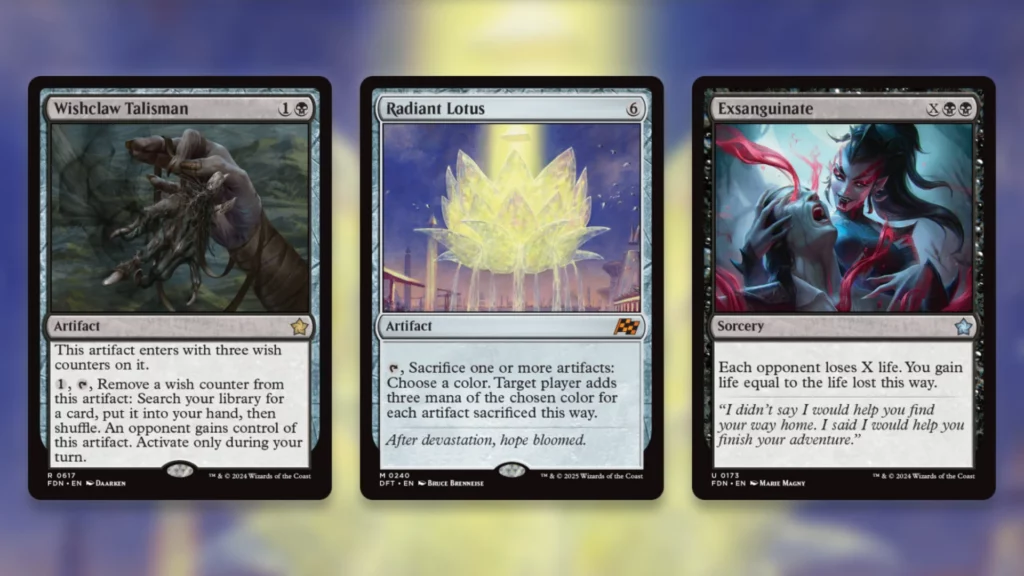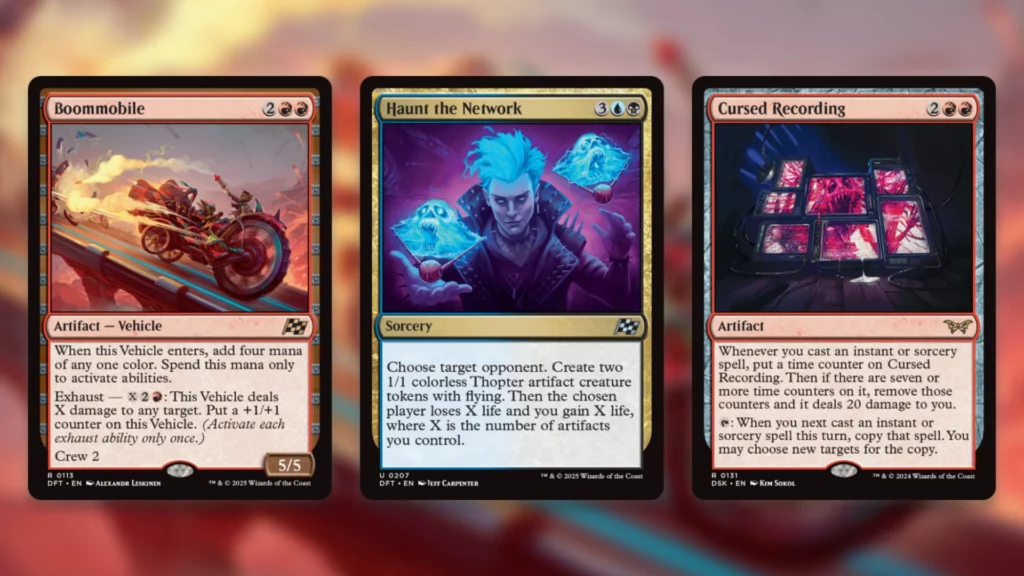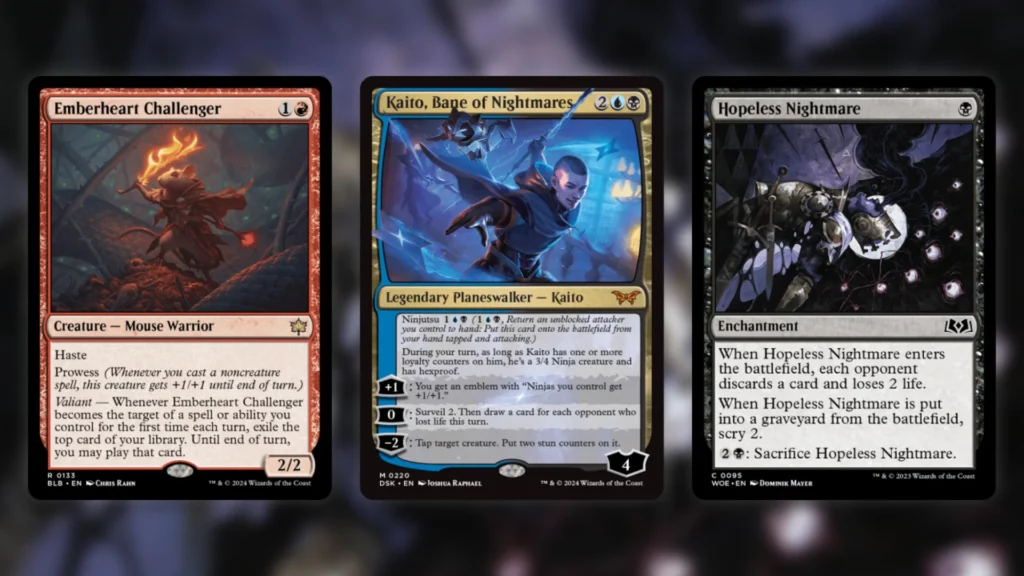Few events in Magic: The Gathering are as exciting as the release of a new Lotus card. Ever since Alpha’s iconic Black Lotus, the name has been synonymous with explosive mana-ramping power. Though most subsequent attempts to print a new Lotus have been underwhelming, the original legacy is so strong that players still sit up straight when a new one is spoiled. They certainly did for Aetherdrift’s Radiant Lotus, and it looks like they were right to do so: the card is already showing up in a number of MTG combo decks in Standard.
This early into a new set, it’s impossible to say anything for certain. That players are experimenting with Radiant Lotus now hardly means it’s destined to take over the format. That said, it is exciting to see it doing work right out of the gate. The card has been fairly controversial since its release, with many doubting its ability to do much of anything in the real world. These early developments don’t disprove the naysayers completely, but they do give them a lot to think about.
MTG Combo Nonsense With Radiant Lotus

The first Radiant Lotus combo deck we’ll be looking at today comes via the ever-reliable MTG Creative Combos on Twitter. This is a mono-black list, built around a single focused gameplan. You amass eight artifacts on the board, you sacrifice them all to Radiant Lotus, and you cast Exsanguinate for an instant kill.
Sounds simple enough, but actually pulling the combo off is another matter. Eight is a lot of artifacts to amass, especially while trying not to die to Standard’s aggressive players. To that end, this list is meticulously constructed to meet its goal. Starting at the bottom of the curve, Grim Bauble and Tithing Blade get things going nicely. These are both solid removal pieces that leave an artifact behind for you to sacrifice later.
Beyond this, the deck runs The Irencrag as a generic mana rock, Thran Spider as a two-artifacts-in-one package deal, and Solemn Simulacrum as a bit of ramp and draw. These are all artifacts, and can therefore be cashed in via Lotus on your combo turn.
The most important card in the deck isn’t any of these great pieces, however, but Wishclaw Talisman. It’s easy to forget this was reprinted in Foundations, but it’s here and it’s a perfect fit for the deck. It’s a cheap tutor for your Exsanguinate or Lotus, and it’s also a card you can sacrifice to Lotus when needed. You can even do this with the tutor ability on the stack, to avoid giving it to your opponent.
This is a fairly simple strategy as far as Magic: The Gathering combos go. It’s not quite as explosive as some combos we’ve seen recently, but it can still end games around turn six/seven with the right hands.
Another Flavor

If mono-black is a bit too passe for your tastes, there’s also a Grixis version of the Radiant Lotus MTG combo deck floating about. This one comes via MTG Goldfish. While still definitely in the combo space, this list is a bit more flexible than the hyper-focused mono-black one above.
That said, it does have a similar core game plan. Ideally, this deck will win by sacrificing eight artifacts to Radiant Lotus and funneling the mana into Boommobile for the win. This is worse than Exsanguinate on multiple fronts since you need to cast Boommobile first and its ability is more mana-intensive to boot. This may well be worth it, however, given that access to red gives the deck more options at other points in the game.
This deck also goes in for the ‘early artifact-based removal’ idea, this time picking Grim Bauble, Tithing Blade, and Chainsaw as its weapons of choice. It also runs Thran Spider for the double artifact hit, but past that, it’s a bit more top-heavy as a list. You’ll find four copies of Ill-Timed Explosion here, as well as a playset of Haunt the Network.
While expensive, Haunt is crucial to the deck’s secondary win condition. If you cast it rather than Lotus with eight artifacts out, you’ll deal 10 damage to your opponent. Double it via Cursed Recording for 22 total damage, and an instant kill. Haunt is also a great card to play before your Lotus turn since it creates two artifacts and softens up your opponent.
The combination of these two victory routes definitely gives the Grixis version more options. That said, it also comes with new problems. More complex mana makes it harder to hit your curve consistently. The lack of Wishclaw Talisman also gives you less access to your key pieces.
The Real Deal?

The fact that Radiant Lotus enables multiple MTG combo decks in the new Standard is exciting, to be sure. Many doubted the card’s capabilities during preview season, but now they seem undeniable. That said, it’s important to keep context in mind. Fun as these combos are, they’ll need to survive in a Standard that’s as fast as it’s ever been.
Gruul Aggro still rules the roost, delivering turn four/five wins without any kind of combo trickery. While the likes of Grim Bauble and Tithing Blade help here, it’s still very possible for Lotus combo decks to be overrun. They don’t put many creatures on the board early on, so one missed removal spell can ruin your whole game.
Even if you can survive, the other top dogs in Standard have plenty of ways to disrupt your combo. Esper Pixie is growing more dominant by the day, with new pieces from Aetherdrift helping a lot in that regard. This is a deck that can shred your hand with ease, making it very difficult to assemble your combo pieces. With no countermagic, the Lotus lists above are very vulnerable to such strategies.
Dimir Midrange, another top-tier deck at the moment, can attack the hand in a similar manner. Between Deep-Cavern Bat and the new Oildeep Gearhulk, you’ll find it tricky to build a winning hand against this one.
Since these are the most-played Standard decks at the moment, prospects for Radiant Lotus combo are looking pretty bleak. I’d expect a lot of refinement will be necessary in order to take it from meme to dream. Looking at these first drafts above, I’d expect some kind of aggressive Grixis artifacts deck that runs the combo as a plan B to be where things settle in the end.
